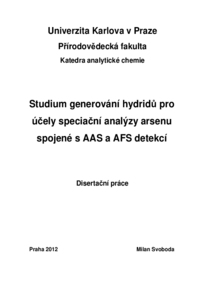Studium generování hydridů pro účely speciační analýzy arsenu spojené s AAS a AFS detekcí
Hydride generation study for arsenic speciation analysis with AAS and AFS detection
dizertační práce (OBHÁJENO)

Zobrazit/
Trvalý odkaz
http://hdl.handle.net/20.500.11956/61109Identifikátory
SIS: 66154
Kolekce
- Kvalifikační práce [19113]
Autor
Vedoucí práce
Konzultant práce
Rychlovský, Petr
Oponent práce
Spěváčková, Věra
Komárek, Josef
Fakulta / součást
Přírodovědecká fakulta
Obor
-
Katedra / ústav / klinika
Katedra analytické chemie
Datum obhajoby
17. 12. 2012
Nakladatel
Univerzita Karlova, Přírodovědecká fakultaJazyk
Čeština
Známka
Prospěl/a
Klíčová slova (česky)
AAS, AFS, generování hydridů, speciační analýza arsenu, kryogenní záchytKlíčová slova (anglicky)
AAS, AFS, hydride generation, speciation analysis of arsenic, cryogenic trappingCílem práce byl rozvoj metodiky a instrumentace speciační analýzy založené na kombinaci selektivního generování substituovaných hydridů s detekcí atomovou absorpční nebo atomovou fluorescenční spektrometrií. Vývoj metodiky a instrumentace speciační analýzy arsenu založené na selektivním generování substituovaných arsanů a využívající záchytu v kryogenní pasti (t.j. chromosorbem plněné skleněné U-trubici) s AAS detekcí (HG-CT-AAS) byl prvním tématem této práce. Byly optimalizovány podmínky selektivního generování substituovaných hydridů a podmínky provozování pasti (výběr přístupu k hydridovému generování, úprava teplotního programu pasti, nově použité sušidlo - patrona s NaOH, možnosti eliminace nespecifické absorpce, možné snížení detekčních limitů). Důležitou součástí práce bylo použití optimalizovaného HG-CT-AAS systému s U-trubicí plněnou chromosorbem pro speciační analýzu arsenu v buněčné suspenzi myších jater. Bylo prokázáno, že buněčnou suspenzi lze dávkovat přímo do hydridového generátoru a tak správně uskutečnit speciační analýzu arsenu, včetně získání informace o oxidačním stavu (iAsIII,V , MAsIII,V a DMAsIII,V ). Pro tyto typy vzorků bylo nutné optimalizovat koncentrace tetrahydroboratu, TRIS pufru a L-cysteinu a také dobu předredukce L-cysteinem. Bylo zjištěno, že nahrazení skleněné...
The general aim of this work was a development of methodology and instrumentation for speciation analysis based on the combination of the selective generation of substituted hydrides with atomic absorption or atomic fluorescence spectrometry detection. The first topic of this work was the development of methodology and instrumentation for arsenic speciation analysis based on selective generation of substituted arsines with trapping in the cryogenic trap (U-tube packed with chromosorb) with AAS detection (HG- CT-AAS). The conditions of the selective hydride generation approach as well as working procedure of the cryogenic trap were optimized (appropriate approach for hydride generation, set up of heating program of cryogenic trap, new dryer - cartidge with NaOH, elimination of unspecific absorption, decreasing of the detection limits). The second important part of the work lay in applying of the developed method for arsenic speciation analysis in a homogenized mouse liver tissue. The direct slurry sampling to hydride generator was develop. Moreover the information about oxidation state (iAsIII,V , MAsIII,V a DMAsIII,V ) was obtain. The effect of relevant experimental parameters such as tetrahydroborate concentration, TRIS buffer concentration and time of pre-reduction of the samples by L-cysteine...
